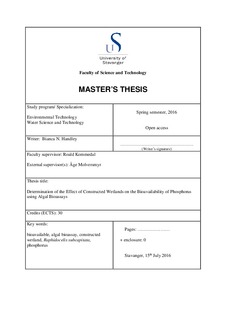| dc.contributor.advisor | Kommedal, Roald | |
| dc.contributor.author | Handley, Bianca | |
| dc.coverage.spatial | Stavanger, Norway | nb_NO |
| dc.date.accessioned | 2016-09-26T13:35:13Z | |
| dc.date.available | 2016-09-26T13:35:13Z | |
| dc.date.issued | 2016-06 | |
| dc.identifier.uri | http://hdl.handle.net/11250/2410655 | |
| dc.description | Master's thesis in Environmental Technology / Water Science and Technology | nb_NO |
| dc.description.abstract | : Phosphorus is the limiting nutrient in most freshwater aquatic environments. When a large amount of phosphorus enters a freshwater environment, such as a lake, this causes a rapid increases in primary production which can lead to anoxic conditions. Anoxic conditions can be detrimental to the local ecosystem as well as ecosystems downstream of this water source. Constructed wetlands have been used worldwide to remediate pollutants, such as phosphorus, from water entering the environment. Wetlands are able to do this through biological, physical and chemical process such as sedimentation, uptake, sorption and precipitation. There is some debate on whether or not this efficiency decreases as the wetland ages and growth rates slow. Studies have concluded that, chemically, constructed wetlands can remove phosphorus. This study is interested in whether or not the wetlands changes the bioavailability of the phosphorus through Leikvollbekken, a mature constructed wetland on the south western coast of Norway which is subject to inflows of nutrient rich run-off from agricultural lands. Experiments were performed over several months to assess the bioavailability at the inlet and the outlet of the wetland. Chemical analysis determined the phosphorus fractions and algal bioassays were used to quantify the amount of bioavailable phosphorus at the inlet and outlet of the constructed wetland. Samples were taken, sterilized, diluted and then split into 5 replicates. Each replicate was inoculated with Raphidocelis subcapitata and the algal growth potential was determined. The results of the algal assays were compared to chemical analysis and demonstrated no removal trend of bioavailable phosphorus from the inlet of the wetland to the outlet. These results were further studied by evaluating the fractionation of the total phosphorus and the bioavailable phosphorus in the inlet and the outlet and concluded that the fractionation of bioavailable phosphorus does change through the wetland. More studies should be done on this wetland using different algal bioassay methods to further determine the speciation of the bioavailable fractions. The wetland should also be studied to evaluate its performance and determine if there is maintenance that can be done to increase its efficiency. | nb_NO |
| dc.language.iso | eng | nb_NO |
| dc.publisher | University of Stavanger, Norway | nb_NO |
| dc.relation.ispartofseries | Masteroppgave/UIS-TN-IMN/2016; | |
| dc.subject | teknisk miljøvern | nb_NO |
| dc.subject | environmental technology | nb_NO |
| dc.subject | bioavailable | nb_NO |
| dc.subject | algal bioassay | nb_NO |
| dc.subject | constructed wetland | nb_NO |
| dc.subject | Raphidocelis subcapitata | nb_NO |
| dc.subject | phosphorus | nb_NO |
| dc.subject | water science | nb_NO |
| dc.title | Determination of the Effect of Constructed Wetlands on the Bioavailability of Phosphorus | nb_NO |
| dc.type | Master thesis | nb_NO |
| dc.subject.nsi | VDP::Technology: 500::Environmental engineering: 610 | nb_NO |
| dc.source.pagenumber | 82 | nb_NO |
